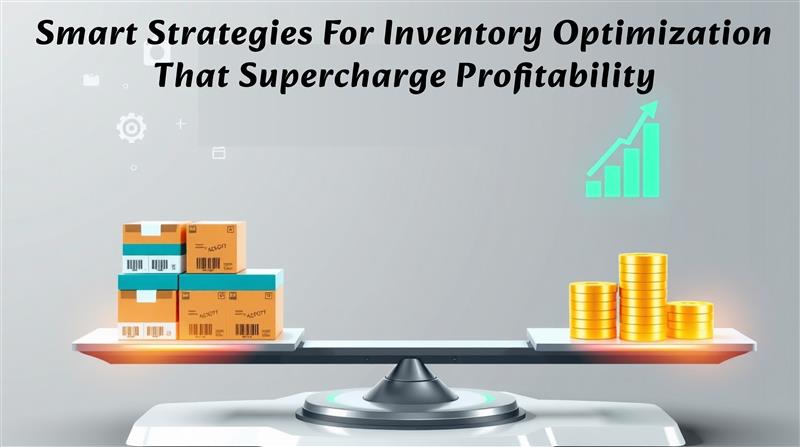Inventory Optimization is the art of keeping just the right amount of stock- no wasted space, no missed sales. In today’s fast-paced market, businesses that can balance demand with supply efficiently gain the competitive edge. Through data-driven forecasting, advanced modeling, and smart tools, Inventory Optimization transforms inventory from a cost center into a strategic asset. This post walks you through proven strategies, emerging tech, and practical tips to make your inventory flow smoother, leaner, and more profitable.
Why Inventory Optimization Matters Now More Than Ever
In an era of supply chain disruptions and heightened customer expectations, getting inventory right is crucial. Inventory Optimization protects working capital, reduces storage and holding costs, and prevents lost sales from stockouts. Companies optimized for agility can respond to shifting demand, market trends, and economic bumps faster-without tying up cash in excess inventory.
Core Pillars of Inventory Optimization
1. Demand Forecasting & Analytics
Accurate forecasting is the foundation of Inventory Optimization. Use historical sales patterns, seasonality, and predictive analytics to anticipate demand. The Economic Order Quantity (EOQ) model helps determine the optimal purchase size to minimize total cost, balancing ordering and holding expenses. Also, setting a proper reorder point-including safety stock for variability-ensures timely replenishment and avoids stockouts.
2. Segmentation: ABC Analysis & SKU Prioritization
Not all products deserve equal attention. With ABC analysis, categorize SKUs into:
- Aitems (high value, tight control),
- Bitems (moderate),
- Citems (low value, minimal management).
- Focus forecasting precision and replenishment strategies where they matter most, optimizing your effort and budget.
3. Networkwide Optimization: Single vs. Multi Echelon
While traditional models optimize each location separately, multi echelon Inventory Optimization considers relationships across the supply network-from central warehouses to retail outlets. This holistic view improves service levels while minimizing total inventory held across all nodes.
4. Safety Stock & Reorder Point Strategies
Calculate reorder points based on expected usage during lead time plus safety stock for variability. This formula helps trigger timely replenishment, even under fluctuating demand or supplier delays. Aligning safety stock with service-level goals avoids overstocking while safeguarding customer satisfaction.
5. Embracing Tech: AI & Automation
Modern Inventory Optimization has leaped forward through AI-powered systems. Major retailers like Target and Walmart now use AI to forecast demand at granular levels, flag misplacements, and dynamically allocate inventory to stores based on local buying patterns. This AI shift enables proactive restocking, reducing both out of stocks and excess inventory.
6. Balancing Just In Time (JIT) & Just In Case
JIT is efficient-but fragile. In volatile markets, blending JIT with “just in case” buffers may be smarter. Identify critical SKUs or regions where a small safety buffer can eliminate costly stock outs without overwhelming your costs.
Key Metrics to Monitor
- Inventory Turnover: How often inventory cycles-better ratios indicate higher efficiency.
- Days Sales of Inventory (DSI): Average days to sell your stock. Lower DSI means improved liquidity and faster cycle times.
- Service Levels / Stock out Rates: High fill rates reflect customer satisfaction and effective inventory control.
Future Trends in Inventory Optimization
AI continues to reshape the landscape. Leading retailers are deploying AI to predict demand fluctuations, detect misplaced stock, and automate reordering-even before humans notice. In manufacturing, AI is also enabling lean “just in time” systems that adapt to real time data, weather disruptions, tariffs, and macroeconomic trends. As adoption grows, Inventory Optimization will become increasingly predictive, precise, and autonomous.
Conclusion
When implemented thoughtfully, Inventory Optimization elevates inventory management from reactive control to proactive strategy.
By blending forecasting, segmentation, mathematical models, and cutting edge tech, businesses can reduce waste, capture sales, and optimize working capital. Start small segment SKUs, model EOQ, forecast smarter and gradually build toward networkwide, AIdriven optimization. The payoff? Leaner operations and happier customers.
For PhD scholars, research on smart inventory strategies shows how data-driven models cut costs, boost efficiency, and raise profit margins. By aligning practices with advanced research insights, businesses gain sustainable growth and set benchmarks in inventory optimization.
FAQs
1. What is the ideal inventory turnover rate?
It varies by industry, but higher turnover typically signals efficient Inventory Optimization and strong sales performance. Compare against industry standards.
2. How often should I review safety stock and reorder points?
At minimum quarterly but monthly is better if demand or supply patterns shift frequently.
3. Can small businesses benefit from Inventory Optimization tools?
Absolutely. Even basic EOQ formulas and ABC analysis can deliver noticeable improvements, especially when manual processes cause overstock or stockouts.
4. Is AI worth investing in now?
Yes-many AI tools offer scalable modules that provide high-impact forecasting and replenishment insights without requiring massive budgets or overhauls.
5. How does Inventory Optimization boost cash flow?
By reducing excess stock and improving turnover, less capital is tied up in inventory, freeing funds for other priorities while minimizing storage costs.





Comments